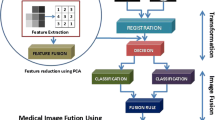Abstract
Present day health information systems aim to provide quality patient care through digitizing the health records that include medical images. The medical images can be tampered through copy-move forgery with a malicious target of hiding some lesions or generating several copies of lesions, causing false treatment that may cost life by attackers, thereby necessitating to perform forgery detection before performing the diagnosis of the patients. The existing methods may not provide satisfactory results as the key-points (KPs) are not uniformly distributed in the entire image region. This paper attempts to develop a new copy-move forgery detection method that spreads the KPs in the whole image region, employs SURF for evaluating the features at identified KPs, applies principle component analysis for dimensionality reduction, uses most valuable player based optimization for optimal clustering of features, and performs feature matching and false match elimination. The paper exhibits the superiority of the proposed method by studying the performances such as accuracy, sensitivity, specificity, precision and F1 on 320 medical images and comparing them with those of existing methods.



Similar content being viewed by others
References
Solanas, A., Patsakis, C., Conti, M., Vlachos, I., Ramos, V., Falcone, F., et al. (2014). Smart health: A context-aware health paradigm within smart cities. IEEE Communications Magazine, 52(8), 74–81. https://doi.org/10.1109/mcom.2014.6871673
Ghoneim, A., Muhammad, G., Amin, S., & Gupta, B. (2018). Medical image forgery detection for smart healthcare. IEEE Communications Magazine, 56(4), 33–37. https://doi.org/10.1109/mcom.2018.1700817
Olanrewaju, R., Othman Khalifa, O., Hashim, A.-H., Akram, Z. M., & Aburas, A. (2011). Forgery detection in medical images using complex valued neural network (CVNN). Australian Journal of Basic and Applied Sciences, 5, 1251–1264.
Abdalla, Y. E., Iqbal, M. T., & Shehata, M. (2017). Copy-move forgery detection based on enhanced patch-match. International Journal of Computer Science, 14(6), 1–7. https://doi.org/10.20943/01201706.17
Ranjani, J., & Babu, M. (2018). Medical image reliability verification using hash signatures and sequential square encoding. Journal of Intelligent Systems, 27(1), 19–30. https://doi.org/10.1515/jisys-2017-0019
Charan, S., Khan, M. J., & Khurshid, K. (2018). Breast cancer detection in mammograms using convolutional neural network. In International conference on computing, mathematics and engineering technologies (iCoMET) (pp. 1–5). https://doi.org/10.1109/ICOMET.2018.8346384
Brunese, L., Mercaldo, F., Reginelli, A., & Santone, A. (2019). Radiomic features for medical images tamper detection by equivalence checking. Procedia Computer Science, 159, 1795–1802. https://doi.org/10.1016/j.procs.2019.09.351
Patel, P. D. K. (2019). Smart healthcare forgery detection using deep learning. International Journal of Advance Research And Innovative Ideas In Education, 5(3), 1670–1674.
Goléa, N., & Melkemi, K. (2019). ROI-based fragile watermarking for medical image tamper detection. International Journal of High Performance Computing and Networking, 13(2), 199. https://doi.org/10.1504/ijhpcn.2019.097508
Khan, M. J., Khurshid, K., & Shafait, F. (2019). A spatio-spectral hybrid convolutional architecture for hyperspectral document authentication. International Conference on Document Analysis and Recognition (ICDAR). https://doi.org/10.1109/ICDAR.2019.00178
Maier, A., Syben, C., Lasser, T., & Riess, C. (2019). A gentle introduction to deep learning in medical image processing. Zeitschrift für Medizinische Physik, 29(2), 86–101. https://doi.org/10.1016/j.zemedi.2018.12.003
Kiruthika, K., Mahalakshmi, S. D., & Vijayalakshmi, K. (2019). Detecting multiple copies of copy-move forgery based on SURF. International Journal of Innovative Science Engineering and Technology, 8(6S), 676–680. https://doi.org/10.35940/ijeat.f1133.0886s19
Ahmad, H., Khan, M. J., Yousaf, A., Ghuffar, S., & Khurshid, K. (2020). Deep learning: A breakthrough in medical imaging. Current Medical Imaging Reviews, 16(8), 946–956. https://doi.org/10.2174/1573405615666191219100824
Uma, S., & Sathya, P. D. (2020). Copy-move forgery detection of digital images using football game optimization. Australian Journal of Forensic Sciences. https://doi.org/10.1080/00450618.2020.1811376
Suganya, D., Thirunadana, S. K., & Sasikala, J. (2021). Copy-move forgery detection of medical images using golden ball optimization. International Journal of Computers and Applications. https://doi.org/10.1080/1206212X.2021.1907905
Bouchekara, H. (2017). Most valuable player algorithm: A novel optimization algorithm inspired from sport. Operational Research, 20(1), 139–195. https://doi.org/10.1007/s12351-017-0320-y
Zhang, Z., Wang, C., & Zhou, X. (2018). A survey on passive image copy-move forgery detection. JIPS, 14, 6–31.
Bay, H., Ess, A., Tuytelaars, T., & Van Gool, L. (2008). Speeded-up robust features (SURF). Computer Vision and Image Understanding, 110(3), 346–359. https://doi.org/10.1016/j.cviu.2007.09.014
Kok, K., & Rajendran, P. (2018). Validation of harris detector and eigen features detector. IOP Conference Series: Materials Science and Engineering, 370, 012013. https://doi.org/10.1088/1757-899x/370/1/012013
Wold, S., & Geladi, p., Esbensen, K., & Öhman, J. (1987). Multi-way principal components and PLS analysis. Journal of chemometrics, 1(1), 41–56.
Morissette, L., & Chartier, S. (2013). The k-means clustering technique: General considerations and implementation in Mathematica. Tutorials in Quantitative Methods for Psychology, 9(1), 15–24. https://doi.org/10.20982/tqmp.09.1.p015
Fischler, M., & Bolles, R. (1981). Random sample consensus: A paradigm for model fitting with applications to image analysis and automated cartography. Communications of the ACM, 24(6), 381–395. https://doi.org/10.1145/358669.358692
Yohannan, R., & Manuel, M. (2016). Detection of copy-move forgery based on Gabor filter. IEEE International Conference on Engineering and Technology (ICETECH), 2016, 629–634. https://doi.org/10.1109/icetech.2016.7569326
Mehak, & Gulati, T. (2017). Improve copy move forgery image classification by optimization technique. International Journal of Advances in Engineering Research, 13(5), 19–29.
Author information
Authors and Affiliations
Corresponding author
Additional information
Publisher's Note
Springer Nature remains neutral with regard to jurisdictional claims in published maps and institutional affiliations.
Rights and permissions
About this article
Cite this article
Suganya, D., Sikamani, K.T. & Sasikala, J. Copy-Move Forgery Detection of Medical Images Using Most Valuable Player Based Optimization. Sens Imaging 22, 44 (2021). https://doi.org/10.1007/s11220-021-00367-x
Received:
Revised:
Accepted:
Published:
DOI: https://doi.org/10.1007/s11220-021-00367-x




